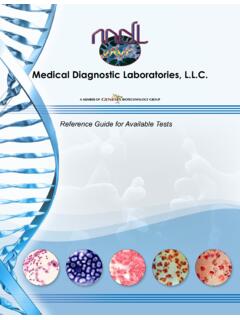Transcription of Bacterial Vaginosis - Medical Diagnostic Laboratories, L.L.C.
1 Bacterial Vaginosis (With lactobacillus Profiling) qPCR Panel The vaginal microflora is a dynamic ecosystem normally inhabited by lactobacilli. These bacteria support healthy vaginal conditions by maintaining an acidic depletion of lactobacilli (C) is observed. A dramatic environment that is inhospitable to other pathogenic increase of the obligate anaerobic bacteria (D) such as microorganisms. L. crispatus, L. gasseri, L. jensenii, Atopobium vaginae, Megasphaera species and BVAB2. and L. iners are considered to be the four major vaginal is also observed during BV and are important indicator lactobacillus species (1, 2, 3). Usually, the vaginal flora organisms associated with the BV state (15).
2 Is dominated by one of these bacteria accompanied by less abundant and less frequently detected minor lactobacillus species including L. acidophilus, L. johnsoni, L. vaginalis, L. fermentum, and L. reuteri (4). The numerical prevalence of lactobacilli in the vagina prevents its colonization by other pathogens. Many important aspects of women's sexual and reproductive health rely on the protective role of lactobacilli in the vaginal environment. The composition of the vaginal microflora is not static but changes over time in response to various Figure 1. Changes of the vaginal microflora associated with endogenous and exogenous influences. The most the development of Bacterial Vaginosis .
3 Common alteration in vaginal microflora is a condition named Bacterial Vaginosis (BV) (1, 4). BV is a disorder characterized by an overgrowth of anaerobic bacteria Epidemiology in the vagina leading to a replacement of healthy lactobacilli. Bacterial species including Gardnerella The prevalence of BV is difficult to determine as the vaginalis, Atopobium vaginae, Megasphaera Type 1 disease can be symptomatic or asymptomatic. Most and Type 2, Bacterial Vaginosis -Associated Bacterium prevalence studies rely on women experiencing 2 (BVAB2), Bacteroides species, Mobiluncus species, symptoms who seek gynecological care and some Mycoplasma species, and Ureaplasma urealyticum have reported that BV affects up to 23% of women are described as indicative Diagnostic markers of BV of reproductive age (14).
4 The prevalence of BV in (5-8). The presence of these microorganisms along the United States is higher among African American with a depletion of the protective lactobacilli suggests women than among women of other racial groups. that vaginal microbial conditions are abnormal. Clinical According to epidemiological studies, up to 46% of symptoms of BV include an increase in vaginal pH, African-American women, compared with only 14%. vaginal discharge and an unpleasant fishy odor. BV is of non-African American women, acquire BV (16, 17). associated with an increased risk of sexually transmitted The basis for this racial disparity has not yet been infections and serious pregnancy complications determined.
5 Although BV is not considered a sexually including miscarriage and preterm birth (5, 9-13). BV transmitted infection, it is rarely observed in women is very common in women of reproductive age and is who have not yet engaged in sexual activity (18). one of the most common reasons that women seek treatment from health care providers (14, 15). Pathogenesis The underlying pathogenesis of BV is hypothesized Bacterial Vaginosis is associated with an increase of to involve a depletion of lactobacilli from the vaginal vaginal pH from a healthy range ( ) to > flora and consequent overgrowth of Gram-negative in which an overgrowth of Gardnerella vaginalis (A), a anaerobes and facultative anaerobes such as G.
6 Modest increase in facultative anaerobes (B) and the Medical Diagnostic Laboratories, vaginalis and Mobiluncus species. The development Increased vaginal pH > of culture-independent molecular diagnostics has The presence of clue cells (exfoliated vaginal greatly increased the number of Bacterial species epithelial cells with attached bacteria) by wet-mount associated with BV to include A. vaginae, Eggerthella microscope. species, Leptotrichia amnionii, Megasphaera species, Positive whiff test or amine test (fishy odor after Mycoplasma species, U. urealyticum, and BVAB2 addition of 10% KOH). (6, 8, 19). The particular ways a woman acquires an The presence of a thin, non-clumping gray-white infection remain unknown.
7 Since microorganisms adherent vaginal discharge. associated with BV are shown to have their natural habitat in the gastrointestinal tract, BV might be an Laboratory BV testing involves Gram staining of vaginal endogenous infection (4). Nevertheless, the prevalence smears, microscopic evaluation and scoring numbers of of BV is higher in sexually active women having sexual Bacterial morphotypes and clue cells according to Nugent contacts with new and/or multiple partners. Decreasing (21) or Ison and Hay (22). Since the majority of Bacterial the number of unprotected sexual encounters may species associated with BV are fastidious anaerobic reduce the overall incidence rate as well as the rate of microorganisms that are either difficult to culture or, re-infection (18).
8 In some cases, have yet to be cultured, the use of conventional microbiological techniques other than Gram staining is not appropriate for BV Diagnostic purposes The precise mechanism of how lactobacilli are depleted (23). and replaced by BV-associated bacteria during BV is also still unknown. One possibility is that a change in Both the Amsel criteria and Nugent scoring approaches vaginal pH is the underlying cause of BV. lactic acid is suffer from subjective interpretation and, as it has been produced by lactobacillus which maintains the vaginal shown in multiple studies, do not perfectly agree with pH between and This environment favors one another (23-25).
9 Up to half of all women who meet the growth of lactobacillus and inhibits the growth the Diagnostic criteria for BV might not exhibit clinical of pathogenic bacteria. Risk factors for BV include symptoms (26). douching, menstruation, and unprotected sexual contact, all of which raise the vaginal pH above the Recently, the utility of molecular techniques, such as optimum for lactobacillus growth (2). quantitative PCR (qPCR), for the quantitation of major Bacterial species inhabiting the vaginal environment of healthy women and BV carriers has been demonstrated Gynecological Complications (1, 8, 19, 27, 28). qPCR assessment of BV-related bacteria correlates significantly with a high sensitivity Women with BV have a three- to four-fold higher risk and specificity to the Nugent score and to a lesser extent for acquisition of Chlamydia trachomatis and Neisseria with Amsel criteria in the diagnosis of BV (19, 23, 25).
10 Gonorrhoeae (13) and are also at higher risk for HIV Application of molecular methods for characterization of vaginal microflora in BV patients has become an accepted infection (10). Women with BV who undergo invasive practice and a major trend in laboratory diagnostics (1). surgery such as a hysterectomy or abortion suffer from post-operative infections two- to three- times more often Table 1. The Sensitivity and Specificity of PCR detection of than women without BV (11). BV is also associated vaginal bacteria in association with BV (19). with pelvic inflammatory disease (12) and endometritis Bacterium Sensitivity % Specificity %. (9). Accurate diagnosis and appropriate treatment of (95% CI) (95% CI).




